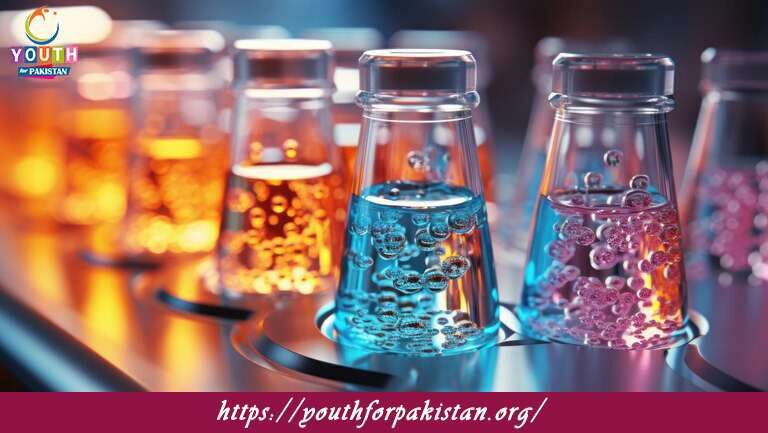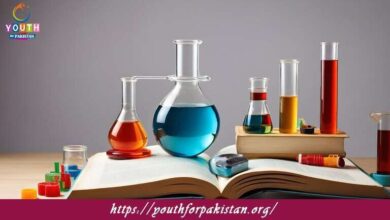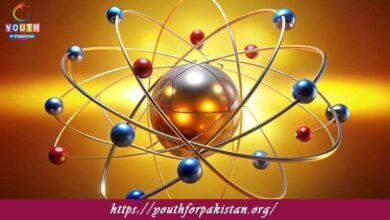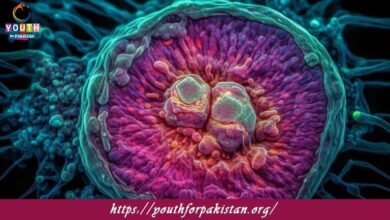9th Class Chemistry Chapter 6 MCQs with Answers

Expand your knowledge base on Solutions by reading this exhaustive set of 9th Class Chemistry Chapter 6 MCQs. Assess your knowledge about solubility, concentration units, and properties of a solution with such well-crafted questions. Keywords trending like a solution chemistry quiz and solubility MCQ make this post suitably followed by the students. Actually, each question has been provided along with the explanation in order to gain proper understanding of the chapter and proper preparation for the exam with a dash of fun.
What is a solution?
A) A heterogeneous mixture
B) A homogeneous mixture
C) A compound
D) A pure element
Which of the following is an example of a solid-gas solution?
A) Saltwater
B) Air
C) Vinegar
D) Lemonade
What is the solvent in a sugar-water solution?
A) Sugar
B) Water
C) Both sugar and water
D) None of the above
What is the solute in a tea solution?
A) Water
B) Tea leaves
C) Sugar
D) None of the above
Which of the following is an example of a liquid-liquid solution?
A) Soda water
B) Air
C) Brass (copper and zin
D) Vinegar
The maximum amount of solute that can dissolve in a given solvent at a specific temperature is called:
A) Solubility
B) Saturation
C) Dilution
D) Concentration
The solubility of most solid solutes in water generally with an increase in temperature.
A) Increases
B) Decreases
C) Remains constant
D) Depends on the solute
What is the solubility of a substance expressed in grams per liter (g/L) called?
A) Concentration
B) Molarity
C) Dilution
D) Mass percent
Which of the following factors does NOT affect the rate of dissolution of a solute in a solvent?
A) Temperature
B) Surface area of the solute
C) Pressure
D) Volume of the solvent
The process of removing solvent from a solution to obtain the solute in its solid form is called:
A) Filtration
B) Distillation
C) Crystallization
D) Decantation
Which of the following is NOT a method to increase the rate of dissolution of a solute in a solvent?
A) Stirring or agitation
B) Increasing the surface area of the solute
C) Decreasing the temperature
D) Heating the solvent
What is the molarity of a solution containing 0.5 moles of solute in 2 liters of solvent?
A) 0.25 M
B) 0.5 M
C) 1.0 M
D) 2.0 M
Which of the following is an example of a saturated solution?
A) Dissolving sugar in water until no more sugar can be dissolved at room temperature.
B) Dissolving salt in water until no more salt can be dissolved at high temperature.
C) Dissolving sugar in water until no more sugar can be dissolved at high temperature.
D) Dissolving salt in water until no more salt can be dissolved at room temperature.
The amount of solute present in a given amount of solvent or solution is called:
A) Solubility
B) Concentration
C) Dilution
D) Saturation
When a solution contains more solute than it can dissolve at a given temperature, it is called:
A) Concentrated
B) Dilute
C) Saturated
D) Supersaturated
Which of the following is an example of a gas-liquid solution?
A) Carbonated water (sod
B) Saltwater
C) Air
D) Vinegar
The solubility of gases in liquids generally with an increase in temperature.
A) Increases
B) Decreases
C) Remains constant
D) Depends on the gas
The process of separating the components of a solution based on their boiling points is called:
A) Filtration
B) Decantation
C) Distillation
D) Crystallization
What is the process of a solute passing through a semipermeable membrane from an area of higher concentration to an area of lower concentration?
a) Diffusion
b) Osmosis
c) Evaporation
d) Filtration
The solubility of most solid solutes in water generally with increasing temperature.
a) Increases
b) Decreases
c) Remains constant
d) Becomes zero
Which of the following is a homogeneous mixture of two or more substances?
a) Compound
b) Element
c) Solution
d) Suspension
The solvent in brass (an alloy of copper and zin is:
a) Copper
b) Zinc
c) Oxygen
d) Water
What type of solution is formed when no more solute can be dissolved in the solvent at a given temperature?
a) Dilute solution
b) Concentrated solution
c) Saturated solution
d) Supersaturated solution
A solution with a pH less than 7 is considered:
a) Neutral
b) Acidic
c) Basic
d) None of the above
Which of the following factors does NOT affect the rate of dissolution of a solid solute in a liquid solvent?
a) Temperature
b) Pressure
c) Surface area of the solute
d) Nature of the solute and solvent
A solution that contains a higher concentration of solute compared to another solution is said to be:
a) Dilute
b) Concentrated
c) Saturated
d) Supersaturated
What is the process of separating a solute from a solution by heating the solution until the solvent evaporates and leaves behind the solute?
a) Filtration
b) Distillation
c) Crystallization
d) Sublimation
The solubility of gases in a liquid generally with increasing temperature.
a) Increases
b) Decreases
c) Remains constant
d) Becomes zero
Which of the following is an example of a gaseous solution?
a) Air
b) Sugar dissolved in water
c) Salt dissolved in water
d) Brass (an alloy of copper and zin
What is the process of a solvent passing through a semipermeable membrane from an area of lower concentration to an area of higher concentration of solute?
a) Diffusion
b) Osmosis
c) Evaporation
d) Filtration
The Tyndall effect is observed when:
a) A beam of light passes through a transparent medium
b) A beam of light passes through a colloid
c) A beam of light passes through a solution
d) A beam of light passes through a suspension
Which of the following is a colloid?
a) Sugar dissolved in water
b) Salt dissolved in water
c) Milk
d) Vinegar
The pH scale ranges from:
a) 0 to 7
b) 0 to 14
c) 7 to 14
d) -7 to 7
What type of solution is formed when more solute can be dissolved in the solvent at a given temperature?
a) Dilute solution
b) Concentrated solution
c) Saturated solution
d) Supersaturated solution
The process of separating a solid from a liquid by using a filter is known as:
a) Filtration
b) Distillation
c) Crystallization
d) Sublimation
Which of the following is NOT a colligative property of solutions?
a) Freezing point depression
b) Boiling point elevation
c) Osmotic pressure
d) Density of the solute
What is the solvent in a solution containing sugar dissolved in water?
a) Sugar
b) Water
c) Oxygen
d) None of the above
The pH of a neutral solution is:
a) 0
b) 7
c) 14
d) None of the above
What is the process of separating the components of a solution based on their different boiling points?
a) Filtration
b) Distillation
c) Crystallization
d) Sublimation
A solution with a pH greater than 7 is considered:
a) Neutral
b) Acidic
c) Basic
d) None of the above
Which of the following is an example of a solid solution?
a) Air
b) Sugar dissolved in water
c) Brass (an alloy of copper and zin
d) Vinegar
The solubility of most gases in water generally with increasing temperature.
a) Increases
b) Decreases
c) Remains constant
d) Becomes zero
What is the process of a solvent passing through a semipermeable membrane from an area of higher concentration to an area of lower concentration of solute?
a) Diffusion
b) Osmosis
c) Evaporation
d) Filtration
The solubility of most solid solutes in water generally with increasing temperature.
a) Increases
b) Decreases
c) Remains constant
d) Becomes zero
Which of the following is a homogeneous mixture of two or more substances?
a) Compound
b) Element
c) Solution
d) Suspension
The solvent in brass (an alloy of copper and zin
c) is:
a) Copper
b) Zinc
c) Oxygen
d) Water
What type of solution is formed when no more solute can be dissolved in the solvent at a given temperature?
a) Dilute solution
b) Concentrated solution
c) Saturated solution
d) Supersaturated solution
A solution with a pH less than 7 is considered:
a) Neutral
b) Acidic
c) Basic
d) None of the above
Which of the following factors does NOT affect the rate of dissolution of a solid solute in a liquid solvent?
a) Temperature
b) Pressure
c) Surface area of the solute
d) Nature of the solute and solvent
A solution that contains a higher concentration of solute compared to another solution is said to be:
a) Dilute
b) Concentrated
c) Saturated
d) Supersaturated
What is the process of separating a solute from a solution by heating the solution until the solvent evaporates and leaves behind the solute?
a) Filtration
b) Distillation
c) Crystallization
d) Sublimation
The solubility of gases in a liquid generally with increasing temperature.
a) Increases
b) Decreases
c) Remains constant
d) Becomes zero
Which of the following is an example of a gaseous solution?
a) Air
b) Sugar dissolved in water
c) Salt dissolved in water
d) Brass (an alloy of copper and zin
What is the process of a solvent passing through a semipermeable membrane from an area of lower concentration to an area of higher concentration of solute?
a) Diffusion
b) Osmosis
c) Evaporation
d) Filtration
The Tyndall effect is observed when:
a) A beam of light passes through a transparent medium
b) A beam of light passes through a colloid
c) A beam of light passes through a solution
d) A beam of light passes through a suspension
Which of the following is a colloid?
a) Sugar dissolved in water
b) Salt dissolved in water
c) Milk
d) Vinegar
The pH scale ranges from:
a) 0 to 7
b) 0 to 14
c) 7 to 14
d) -7 to 7
What type of solution is formed when more solute can be dissolved in the solvent at a given temperature?
a) Dilute solution
b) Concentrated solution
c) Saturated solution
d) Supersaturated solution
If you are interested to enhance your knowledge regarding Physics, Chemistry, Biology, and Computer please click on the link of each category, you will be redirected to dedicated website for each category.





